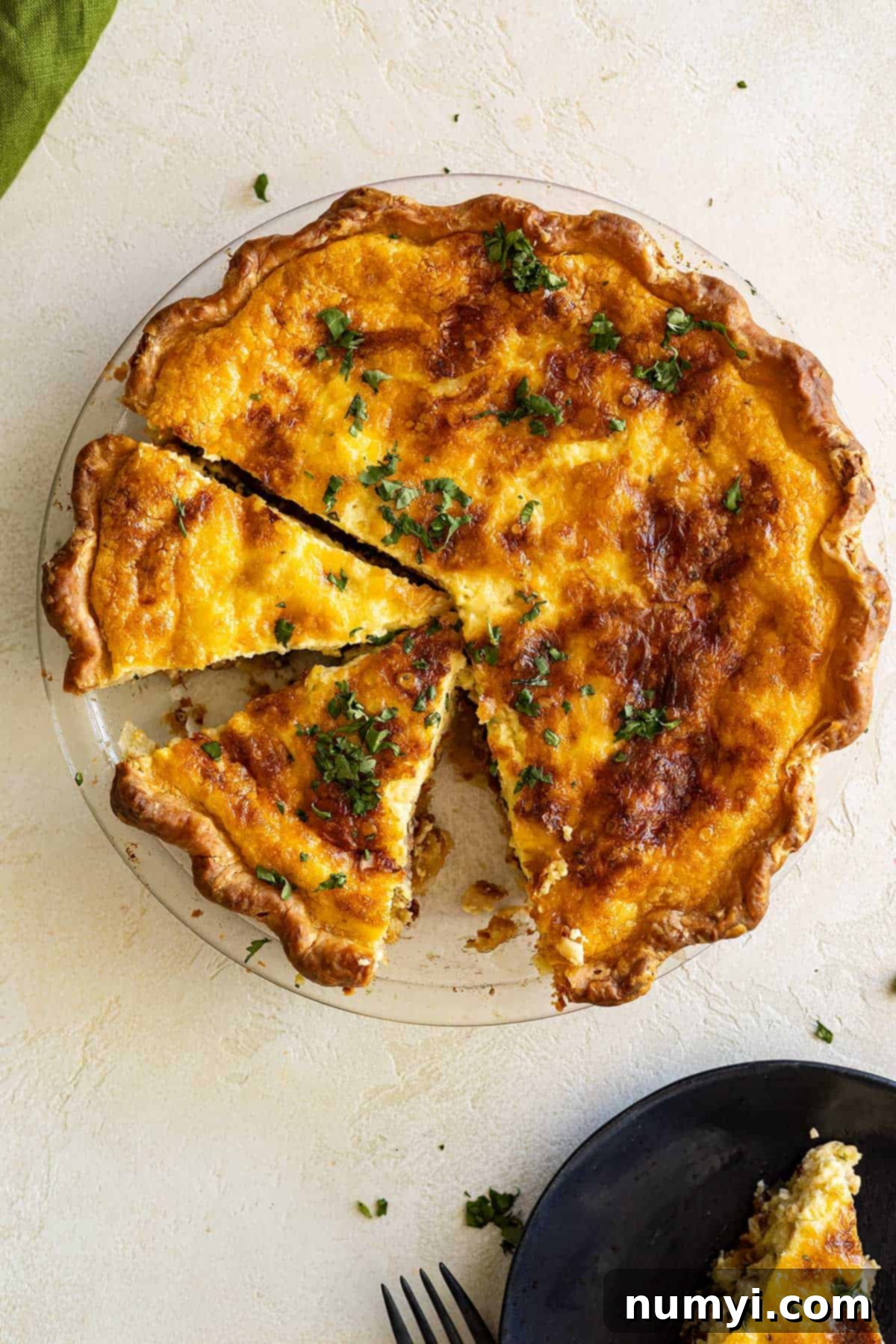Classic Quiche Lorraine: The Ultimate Savory Pie Recipe for Brunch, Lunch, or Dinner
There are few dishes as universally beloved and versatile as Quiche Lorraine. Originating from the Lorraine region of France, this iconic savory tart features a delightful balance of a tender, flaky crust and a rich, creamy filling. Our recipe elevates this classic, ensuring every bite is packed with the exquisite flavors of crispy bacon, sweet caramelized onions, and nutty Gruyère cheese, all suspended in a silky egg custard. Whether you’re planning a elegant brunch, a casual lunch, or a comforting dinner, Quiche Lorraine is always a perfect, satisfying choice.
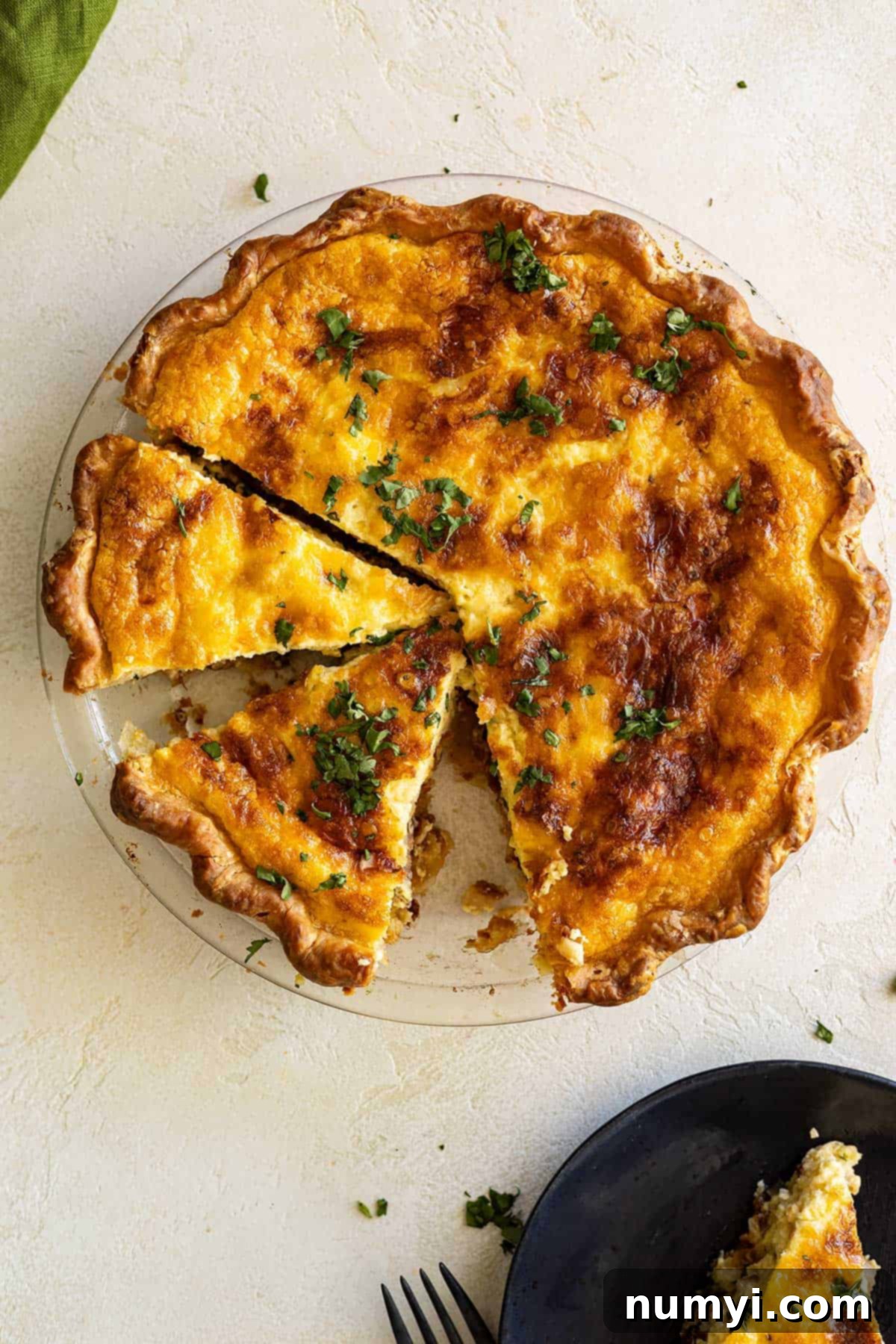
Why This Quiche Lorraine Recipe Will Become Your New Favorite
If you’ve been searching for a reliable and utterly delicious Quiche Lorraine recipe, look no further. This version is more than just a breakfast item; it’s a culinary masterpiece that shines at any time of day. Its incredible richness, depth of flavor, and satisfying texture make it a standout dish. Imagine a flaky, buttery crust giving way to a luscious filling where savory bacon bits, sweet caramelized onions, and a generous amount of melted Gruyère cheese are enveloped in a velvety egg and cream custard. It’s truly a dish that comforts and impresses, whether you’re serving it warm from the oven or chilled to perfection. Beyond its delicious taste, this quiche is surprisingly easy to make and offers fantastic make-ahead and freezer-friendly options, making it a go-to for busy weeks or entertaining.
While this Quiche Lorraine is a top contender for a weekend feast, I also adore whipping up other delightful morning meals. Some of my other favorites include these amazing Swedish Pancakes, a comforting Berry Baked Oatmeal, or the ever-popular Breakfast Enchiladas. But for a truly special and savory experience, Quiche Lorraine holds a unique place in my heart.
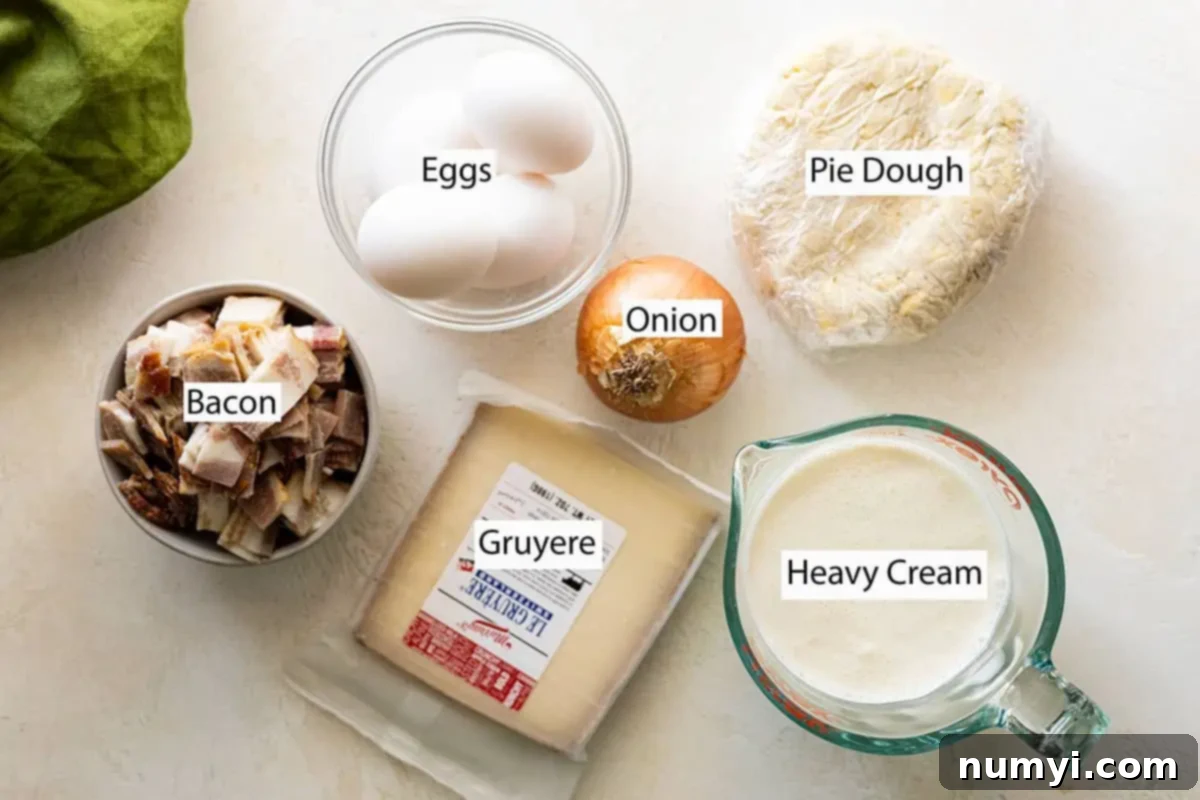
Diving Deep into the Ingredients for Perfect Quiche Lorraine
The magic of Quiche Lorraine lies in the quality and harmony of its few, but essential, ingredients. Each component plays a crucial role in creating the signature flavor and texture. Let’s explore what makes each ingredient vital to this classic dish.
Pie Dough: The Foundation of Flavor
A truly great Quiche Lorraine starts with an exceptional crust. The ideal pie dough should be flaky, buttery, and sturdy enough to hold the rich filling without becoming soggy. You have options here: feel free to use a homemade pie crust for that extra touch of love and control over the texture, or opt for a good quality store-bought one for convenience. Either way, you’ll need one nine-inch pie crust for this recipe. The key to a non-soggy bottom, which we’ll discuss further, is proper pre-baking, also known as blind baking.
Bacon: The Savory Star
Crispy bacon is non-negotiable for a traditional Quiche Lorraine. Its salty, smoky notes are what truly define the dish. We’re looking for strips of bacon cut into small pieces and cooked until perfectly crisp. This not only renders out delicious fat for cooking the onions but also provides a delightful textural contrast against the creamy custard. While classic, you can also experiment with pancetta or even a good quality smoked ham if you’re looking for subtle variations.
Onion: The Sweet Aromatic Base
A small minced onion might seem humble, but when sautéed with the bacon, it caramelizes and releases a subtle sweetness that beautifully balances the richness of the other ingredients. The process of caramelizing onions adds a layer of depth and complexity to the quiche’s overall flavor profile that shouldn’t be skipped. Shallots can also be a wonderful, milder alternative if you prefer a less pungent onion flavor.
Cheese: The Heart of the Quiche
For an authentic Quiche Lorraine, Gruyère cheese is the gold standard. Its nutty, earthy, and slightly sweet flavor melts beautifully, contributing to the creamy texture and adding an unparalleled savory depth. We recommend about 4 ounces (113g) of shredded Gruyère. If Gruyère is hard to find or not to your taste, Swiss cheese is an excellent, readily available substitute that offers a similar mild, nutty profile. Other good melting cheeses like Emmental, white cheddar, or even a blend could work, but Gruyère truly offers the most classic experience.
Eggs: The Custard’s Core
Eggs form the essential foundation of the quiche’s creamy custard. You’ll need 4 large eggs, which, when combined with heavy cream, create that perfectly set yet tender consistency. Ensure your eggs are fresh, as they are central to the texture and flavor of the filling.
Heavy Cream: For Unrivaled Richness
This is where the “rich and creamy” truly comes to life. I strongly recommend using 1½ cups (355ml) of heavy cream. Do not substitute with milk or half-and-half if you want that truly silky, decadent custard texture that defines a great Quiche Lorraine. Heavy cream, with its higher fat content, prevents the custard from becoming watery or rubbery, ensuring a luxurious mouthfeel.
Seasoning: The Finishing Touch
Simple salt and pepper are essential to enhance all the flavors. Additionally, a pinch of freshly grated nutmeg is a classic French touch that subtly complements the cheese and cream, adding a warm, aromatic note without being overpowering.
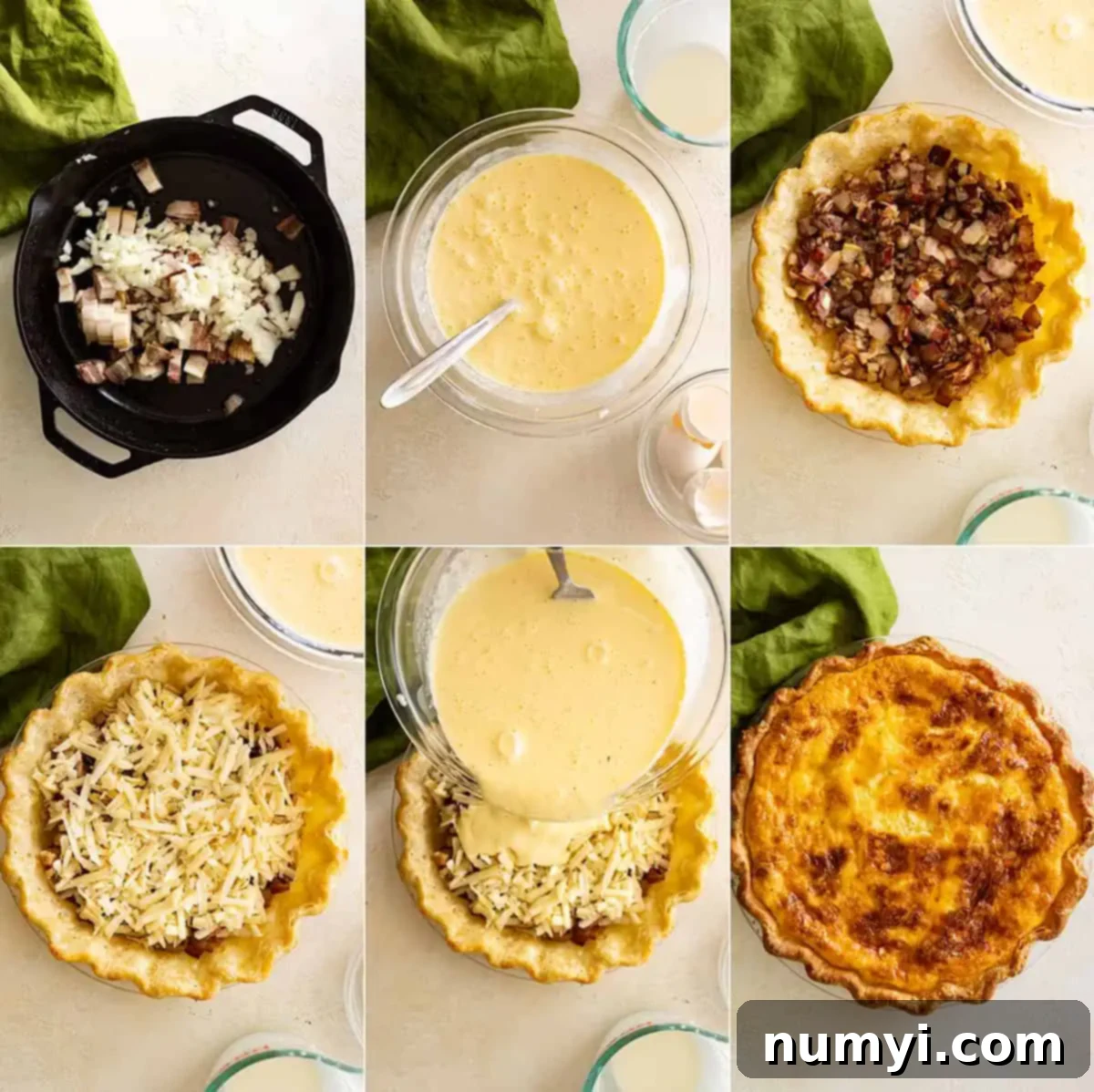
How To Master Your Quiche Lorraine: A Step-by-Step Guide
Making Quiche Lorraine is a straightforward process, but paying attention to a few key details will ensure a perfect result every time. This section provides an expanded overview of the method. For precise measurements and detailed, step-by-step instructions, please refer to the comprehensive recipe card at the end of this post.
Step 1: Preparing the Pie Dough for a Flawless Crust
The secret to avoiding a soggy bottom crust, which is a common quiche pitfall, lies in proper preparation. Start by lining a nine-inch pie plate with your chosen dough. Carefully flute or crimp the edges for an appealing finish. Crucially, you must then par-bake (or blind bake) the shell. This process partially cooks the crust before the filling is added, creating a barrier against moisture and ensuring a wonderfully crisp base. Don’t skip this step!
To par-bake, chill your dough-lined pie plate for at least 30 minutes to help prevent shrinking. Then, line the dough with parchment paper and fill it with pie weights or dried beans. Bake until the edges are lightly browned, usually around 10 minutes. Remove the weights, prick the bottom of the crust with a fork (this allows steam to escape), and bake for another 5-8 minutes until the bottom is just set and lightly golden. This creates the perfect foundation for your quiche.
Step 2: Crafting the Flavorful Filling
With your crust par-baked, it’s time to assemble the delicious filling. In a large skillet, cook your bacon pieces and minced onion together until the bacon is delightfully crispy and the onions are softened and lightly caramelized. This step infuses the bacon fat with onion flavor, creating a rich base. Drain off any excess fat if desired, then evenly spread this mixture into your par-baked pie shell. Next, generously sprinkle the shredded Gruyère or Swiss cheese over the bacon and onion mixture.
In a separate medium bowl, whisk together the eggs and heavy cream until just combined. Avoid over-whisking, as too much air can cause the custard to puff up excessively and then fall. Season this creamy mixture with salt, pepper, and a pinch of nutmeg to taste. Carefully pour the custard mixture over the cheese and bacon in the pie shell. Transfer the quiche to your preheated oven and bake for approximately 40-45 minutes, or until the center is just set with a slight wobble. A knife inserted near the center should come out clean. Allow it to cool for at least 15 minutes before slicing and serving; this helps the custard set completely.
Make-Ahead And Freezer-Friendly Quiche Lorraine: Perfect for Meal Prep!
Quiche Lorraine is an absolute dream for meal prepping and entertaining, thanks to its excellent make-ahead and freezer-friendly properties. Enjoy a delicious, homemade meal with minimal effort when you plan ahead!
Make-Ahead Options:
- Prepare Pie Dough in Advance: Your pie dough can be prepared up to 5 days ahead of time and stored tightly wrapped in the refrigerator. For longer storage, it can be frozen for up to 3 months. This is a huge time-saver!
- Pre-Bake the Crust: You can even pre-bake, or blind bake, your pie crust up to 1 day in advance. Once fully cooled, store it at room temperature, loosely covered, until you’re ready to fill and bake the quiche.
- Bake the Entire Quiche: For ultimate convenience, bake the quiche according to the instructions, then allow it to cool completely on a wire rack. Once cooled, cover it tightly with plastic wrap or foil and refrigerate for 2-3 days. You can serve it cold for a picnic or light lunch, or gently reheat individual slices in the microwave or the entire quiche in the oven until warmed through.
Freezer-Friendly:
Quiche Lorraine freezes beautifully, making it an ideal option for future meals. After baking the quiche as instructed, allow it to cool completely to room temperature. This is crucial to prevent ice crystals from forming. Once fully cooled, wrap the entire quiche (or individual slices for easy portioning) very well with several layers of heavy-duty aluminum foil, and then an additional layer of plastic wrap to prevent freezer burn. Label with the date and freeze for up to 2 months.
To reheat frozen quiche: for best results, thaw the quiche overnight in the refrigerator. Once thawed, unwrap it and bake, uncovered, at 300°F (150°C) for 20-30 minutes, or until thoroughly warmed through and the crust is crisp again. If reheating from frozen (without thawing), increase the baking time to 45-60 minutes, covering loosely with foil if the crust starts to brown too quickly. A quick tip: for individual slices, a toaster oven or air fryer can also work wonders for reheating and crisping up the crust.

Essential Tips for Quiche Lorraine Perfection
The Importance of Partially Blind Baking the Pie Crust
This step is absolutely critical and often overlooked, but it’s the ultimate defense against a dreaded soggy bottom crust. Please, do not skip this to save time! If you do, the moisture from the egg custard will seep into the raw dough, resulting in a wet, unappealing crust. This process is also famously known as Blind Baking Pie Crust, and mastering it will elevate your quiche game significantly.
- Chill Your Dough: Whether homemade or store-bought, pie crust needs to be cold. If making your own, refrigerate for at least 2 hours. Store-bought dough should be taken directly from the fridge when ready to use.
- Form and Chill Again: Roll out your dough and carefully fit it into your 9-inch pie dish. Crimp or flute the edges decoratively. Then, chill the shaped pie crust for at least 30 minutes. This second chilling prevents the dough from shrinking during baking and helps maintain those beautiful fluted edges.
- Prepare for Baking: Line the chilled dough with a piece of parchment paper, ensuring it covers the bottom and sides. Fill the parchment paper with ceramic pie weights or dry beans. These weights prevent the crust from puffing up and shrinking.
- Initial Bake: Bake in a preheated oven until the edges of the crust are lightly golden brown, typically about 10 minutes.
- Remove Weights and Prick: Carefully remove the pie weights and parchment paper. Using a fork, prick the bottom of the crust all over. This creates small vents for steam to escape, preventing large bubbles.
- Second Bake: Return the crust to the oven and bake for an additional 5-8 minutes, or until the bottom is light golden and looks relatively dry.
- Ready for Filling: Your par-baked crust is now ready to be filled with the rich quiche custard and baked to perfection.
How To Prevent Overbrowning
As you might notice from some of the pictures, quiche can sometimes brown a bit too much on top, especially around the edges. While mine still tasted absolutely amazing, it’s not always the ideal aesthetic. The rich fat content in the cream and cheese, combined with the sugar in the caramelized onions, can accelerate browning. If your quiche is starting to brown too quickly, particularly during the last 15-20 minutes of baking, simply tent the pie loosely with a piece of aluminum foil. This will shield the top from direct heat, allowing the custard to finish cooking without over-browning the crust or filling.
Don’t Overbake Your Quiche!
One of the most common mistakes in quiche making is overbaking. An overbaked quiche will result in a rubbery, dense custard rather than the desired silky, tender texture. To check for doneness, gently jiggle the pie plate. The edges should be set, but the very center should still have a slight, delicate wobble. A thin knife inserted near the center should come out mostly clean. Remember that the quiche will continue to cook slightly from residual heat as it cools, so a little wobble is perfect. Allow it to cool for at least 15 minutes before slicing; this allows the custard to fully set and makes for cleaner cuts.
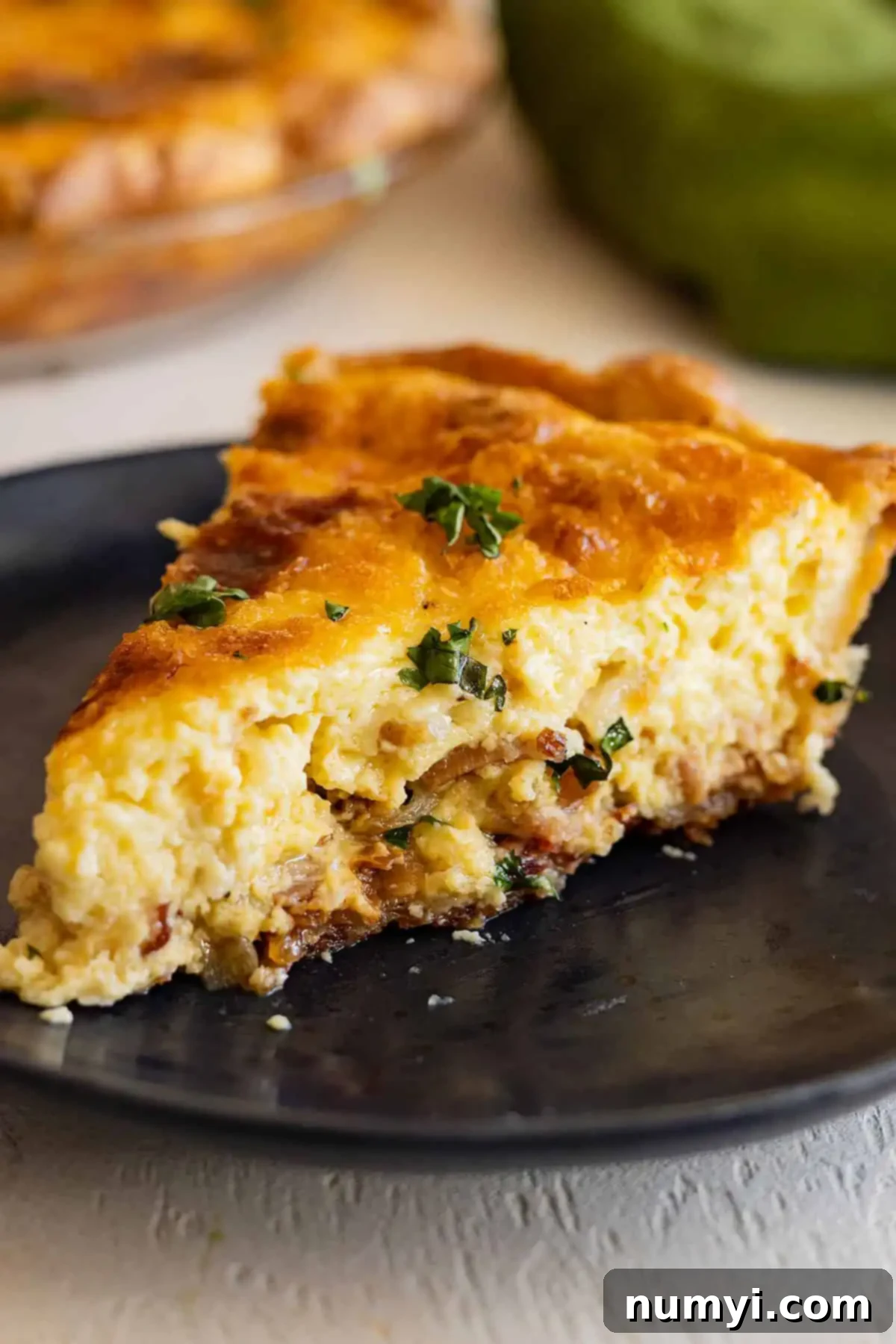
Serving Suggestions: What to Pair with Quiche Lorraine
Quiche Lorraine is inherently rich and satisfying, so it pairs best with lighter, fresh accompaniments that provide a delightful contrast and cleanse the palate. Avoid serving anything too heavy alongside it to maintain a balanced meal. Here are some ideal ideas:
- Easy Fruit Salad: The sweetness and acidity of fresh fruit are a perfect counterpoint to the savory quiche. Think berries, melon, grapes, and citrus segments for a vibrant, refreshing side.
- Pear Salad with Apricots: A delightful mix of crisp pears and sweet apricots in a light salad adds a touch of gourmet elegance.
- Spinach Apple Pomegranate Salad: This salad brings together fresh spinach, crisp apple slices, and juicy pomegranate seeds, offering a fantastic texture and flavor contrast.
- Any Green Salad: A simple mixed green salad with a light vinaigrette is always a winner. Consider adding a few cherry tomatoes, cucumber slices, or toasted nuts for extra crunch and color.
- Roasted Potatoes: While quiche can be quite filling, if you’re serving it for a more substantial meal, a side of simple roasted potatoes can be a comforting addition. Ensure they are well-seasoned and crispy!
- Steamed Asparagus: Lightly steamed or roasted asparagus spears offer a delicate flavor and vibrant green color that complements the quiche beautifully.
- Crusty Bread: A slice of crusty baguette is perfect for soaking up any creamy goodness from the quiche.
For beverages, coffee or tea are perfect for breakfast/brunch. For an adult brunch, mimosas or a crisp, dry white wine like Sauvignon Blanc or a light sparkling wine would be excellent choices for dinner.
Quiche Lorraine Variations to Inspire Your Creativity
While classic Quiche Lorraine is undeniably delicious, it also serves as a fantastic base for countless variations. Don’t be afraid to get creative and customize your quiche to your liking! Here are a few ideas:
- Spinach and Feta Quiche: Sauté fresh spinach until wilted, squeeze out excess moisture, and combine with crumbled feta cheese before adding to the crust.
- Mushroom and Swiss Quiche: Sauté sliced mushrooms until golden brown, then layer with shredded Swiss cheese. A touch of thyme would be a great addition.
- Broccoli and Cheddar Quiche: Blanch small broccoli florets, chop them, and combine with sharp cheddar cheese for a family-friendly favorite.
- Smoked Salmon and Dill Quiche: For a more gourmet twist, layer flaked smoked salmon with fresh dill and a squeeze of lemon juice, using perhaps crème fraîche in place of some heavy cream for extra tang.
- Roasted Vegetable Quiche: Roast your favorite seasonal vegetables (bell peppers, zucchini, asparagus, cherry tomatoes) until tender, then combine with a mild cheese like Monterey Jack or mozzarella.
- Goat Cheese and Sun-Dried Tomato: The tangy goat cheese and sweet, concentrated flavor of sun-dried tomatoes make a sophisticated pairing.
Frequently Asked Questions About Quiche Lorraine
Here are some common questions people ask about making and enjoying Quiche Lorraine:
- Can I make Quiche Lorraine without bacon?
- While classic Quiche Lorraine traditionally includes bacon, you absolutely can make it without for a vegetarian version. You could substitute with sautéed mushrooms, spinach, or roasted vegetables. For a smoky flavor, consider adding smoked paprika or a touch of liquid smoke to the onions.
- What’s the best cheese for Quiche Lorraine?
- Gruyère is widely considered the best cheese for authentic Quiche Lorraine due to its distinct nutty, savory flavor and excellent melting properties. Swiss cheese is a great substitute, and Emmental is also a good choice. You can experiment with other good melting cheeses, but for the true classic, Gruyère is recommended.
- How do I know when my quiche is done?
- Your quiche is done when the edges are set and lightly golden, but the very center still has a slight, delicate wobble when you gently shake the pie plate. A thin knife inserted near the center (about an inch from the edge) should come out mostly clean. Remember, it will continue to set as it cools.
- Can I use a store-bought pie crust?
- Yes, absolutely! While a homemade crust adds an extra touch, a good quality store-bought pie crust is perfectly acceptable and a great time-saver. Just ensure you still follow the blind-baking steps to prevent a soggy bottom.
- Why is my quiche soggy on the bottom?
- A soggy bottom crust is almost always due to not properly blind baking the pie crust. The raw dough absorbs moisture from the custard. Always par-bake your crust thoroughly with pie weights before adding the filling to create a moisture barrier.
HUNGRY FOR MORE? Subscribe to my newsletter and follow along on Pinterest, Facebook, and Instagram for all my latest updates!
Quiche Lorraine Recipe
Quiche Lorraine is made with a flaky buttery crust and a rich, creamy, and savory filling made with eggs, crispy bacon, caramelized onions, and cheese. Whether served hot or cold, Quiche Lorraine is a perfect addition to any brunch, lunch, or dinner table.
Servings: 8
Prep Time: 1 hour
Cook Time: 40-45 minutes
Total Time: 1 hour 40 minutes
Author: Malinda Linnebur
Ingredients
- 1 pastry for a one crust 9-inch pie (homemade or store-bought)
- 8 strips bacon, cut into small pieces
- 1 small onion, minced
- 4 ounces (113g) shredded Gruyere or Swiss cheese
- 4 large eggs
- 1½ cups (355ml) heavy cream
- Salt and pepper to taste
- Pinch of freshly grated nutmeg (optional, but recommended)
Instructions
- Prepare Crust: Line a nine-inch pie plate with pie dough. Flute the edges. Place in the refrigerator for 30 minutes to chill.
- Par-Bake Crust: Preheat oven to 400℉ (200°C). Remove pie plate from the refrigerator and line with a piece of parchment paper. Fill with pie weights or dried beans. Bake for 10 minutes. Remove weights and parchment paper, then pierce the dough with a fork all over the bottom. Bake for an additional 5-8 minutes, or until the bottom is lightly golden and dry. Remove from the oven and set aside.
- Reduce Oven Temperature: Reduce oven temperature to 350℉ (175°C).
- Prepare Filling Base: In a large skillet, cook the bacon and minced onion until the bacon is crisp and the onion is softened and lightly caramelized. Drain off any excess fat. Add this mixture to the par-baked pie shell. Top evenly with the shredded cheese.
- Make Custard and Bake: In a medium bowl, whisk together the eggs and heavy cream. Season generously with salt and pepper to taste, and add a pinch of nutmeg if using. Pour the custard mixture carefully over the cheese in the pie shell. Bake for 40-45 minutes, or just until the center is set with a slight jiggle. If the crust or top starts to brown too quickly, loosely tent with foil.
- Cool and Serve: Allow the quiche to cool on a wire rack for at least 15 minutes before serving. This allows the custard to fully set. Enjoy warm or at room temperature.
Notes
- STORAGE: Store any leftover Quiche Lorraine at room temperature for up to 6 hours after baking. Otherwise, once it has cooled completely, cover tightly and store in the refrigerator for up to 3 days.
- MAKE-AHEAD & FREEZING: Refer to the “Make-Ahead And Freezer-Friendly” section above for detailed instructions on preparing components or the entire quiche in advance, and for freezing and reheating tips.
- PREVENT OVERBROWNING: If your quiche starts to brown too quickly during baking, loosely tent it with aluminum foil. As mentioned, the quiche in some of these pictures is a bit too brown, but still tasted great!
Nutrition (Approximate per serving)
Calories: 367kcal | Carbohydrates: 13g | Protein: 9g | Fat: 31g | Saturated Fat: 15g | Polyunsaturated Fat: 1g | Monounsaturated Fat: 6g | Trans Fat: 0.01g | Cholesterol: 167mg | Sodium: 573mg | Potassium: 101mg | Fiber: 0.1g | Sugar: 2g | Vitamin A: 922IU | Vitamin C: 1mg | Calcium: 189mg | Iron: 1mg
Did you make this?
Let me know by sharing a picture and tagging @countryside_cravings on Instagram!
